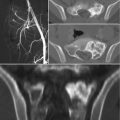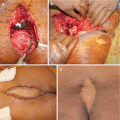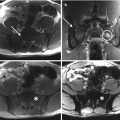Fig. 3.1
Sacral nerve roots (2016, June). Retrieved July, 2016, from http://wiki.ahuman.org/index.php/HumanNervesSpinalRoots
As this continues to progress, motor deficits, and eventually, bladder, bowel, and/or sexual dysfunction from anterior extension of the tumor into the presacral space can be noted [1].
Involvement of lumbosacral nerve roots in sacral lesions leads to certain specific deficits. A lesion involving the L-5 nerve root, commonly in its L5-S1 foraminal or extraforaminal course, may cause radicular pain and hypesthesias in the lateral thigh and calf as well as dorsum of the foot to the great toe [1, 2, 4]. Motor weakness of the L-5 nerve root may result in weakened ankle dorsiflexion, great toe extension, knee flexion, and hip abduction. The straight-leg raise test, or Lasegue’s sign, which involves raising the patients leg with a straight knee while the patient is supine, would result in sciatic pain and render a positive result. A lesion involving the S-1 nerve root, in its canalicular, S1-2 foraminal or extraforaminal course, typically causes radicular pain and hypesthesias in the posterior thigh and calf as well as at the lateral and plantar face of the foot and the small toe. A motor deficit due to an S-1 lesion may result in weakened ankle plantar flexion, knee flexion, and hip extension. A unilateral lesion to the S2 or S3 nerve root usually leads to mild or moderate bladder, bowel, and/or sexual dysfunction [8, 9]. A bilateral lesion of the S2 or S3 roots almost always results in complete bladder, bowel, and sexual dysfunction, and although a unilateral lesion at the same nerve root may cause symptoms, they are generally more nonspecific. However, unilateral or even bilateral lesions of the S4 and/or S5 roots do not result in autonomic dysfunction, although anatomical work has shown some S4 and S5 root contribution to bladder and bowel function [10]. Performance of a thorough physical exam in such patients is critical and can significantly aid in diagnosis and ancillary testing.
Conflict-of-Interest Statement
No benefits have been or will be received from a commercial party related directed or indirectly to the subject matter of this article.







